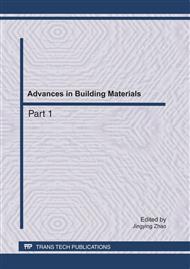p.223
p.228
p.233
p.238
p.242
p.247
p.252
p.256
p.260
Investigating Properties of Haydite Concrete by Using Taguchi Method
Abstract:
Functionally Graded Material (FGM), as a new concept in material fields, has been a research hotspot in recent years, the application of which can improve the stress state of structures. This paper tried to introduce FGM into the concrete material by investigating the factors which have influence on the concrete FGM. In this study, mix proportion parameters of haydite concrete are analyzed by using the Taguchi’s experiment design methodology. Mixtures are designed in a L16 (45) orthogonal array with three factors, namely, “volume fraction of haydite in total aggregate (H/A)”, “water/cementitious material (W/C) ratio”, and “air entraining agent (AE) content”. The mixtures are extensively tested. The experimental results are analyzed by using the variance analysis (ANOVA). The influence degree of three selected factors to performance indexes is obtained.
Info:
Periodical:
Pages:
242-246
Citation:
Online since:
May 2011
Authors:
Price:
Сopyright:
© 2011 Trans Tech Publications Ltd. All Rights Reserved
Share:
Citation:


